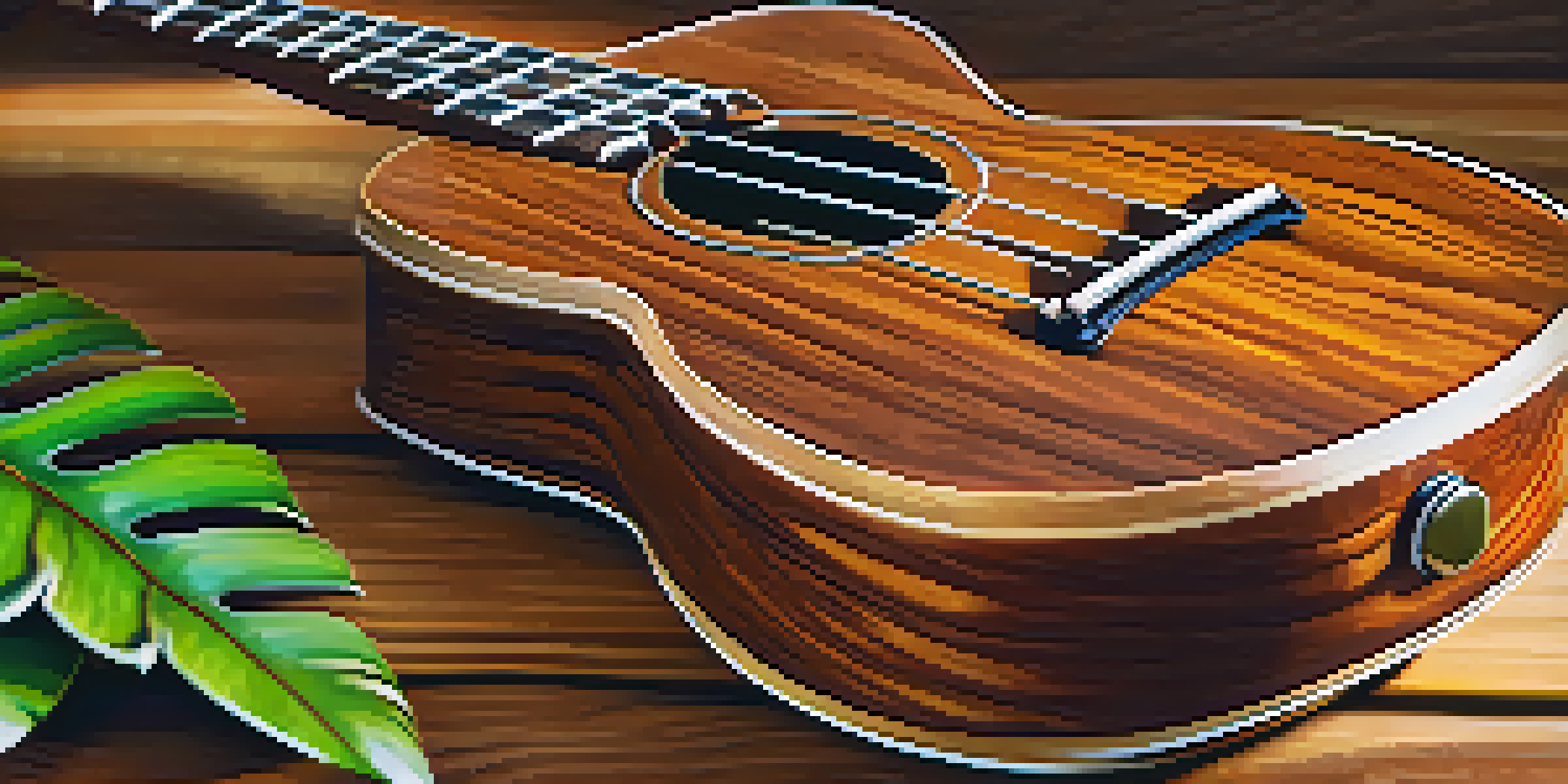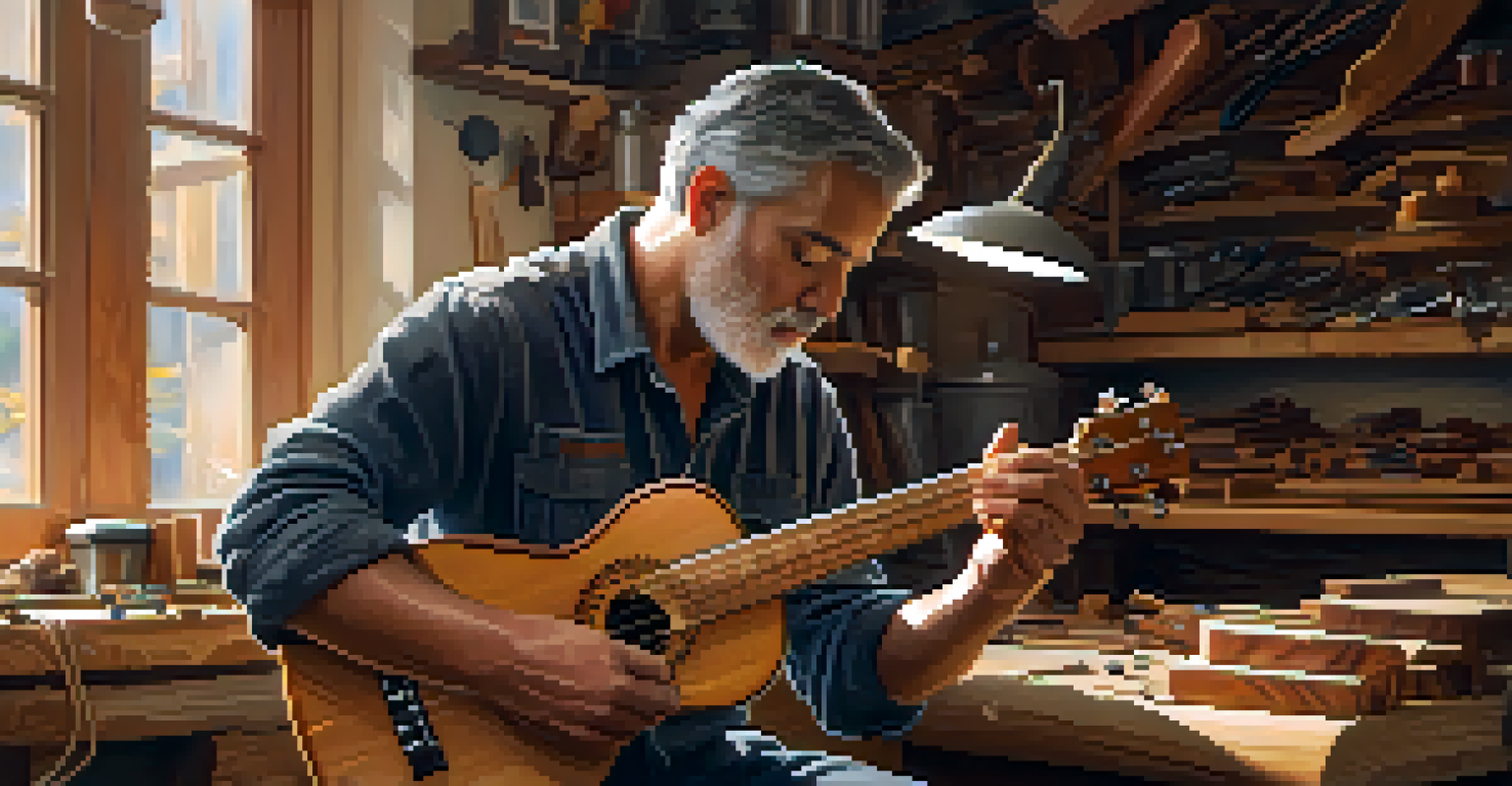The Art of Ukulele Making: A Journey Through Craftsmanship

Understanding the Ukulele: A Brief History
The ukulele, a charming four-stringed instrument, has its roots in the 19th century. Originating from Hawaii, it was inspired by similar stringed instruments brought by Portuguese immigrants. This lively little instrument quickly became a symbol of Hawaiian culture and music, captivating hearts around the world.
The ukulele is the only instrument that can make you smile just by picking it up.
Over the years, the ukulele evolved, attracting musicians from various genres, from folk to jazz. Its compact size and cheerful sound made it a favorite for both amateur and professional musicians. Today, the ukulele continues to thrive, with countless players enjoying its unique tones.
Understanding the history of the ukulele not only enriches our appreciation for the instrument but also highlights the craftsmanship that has gone into its making. Each ukulele tells a story of tradition, creativity, and cultural exchange.
The Materials That Make a Ukulele Unique
When it comes to crafting a ukulele, the choice of materials is crucial. Common woods like mahogany, koa, and spruce each bring distinctive tonal qualities and aesthetics to the instrument. For instance, koa wood, native to Hawaii, is prized for its warm sound and beautiful grain, making it a popular choice among luthiers.

Beyond wood, other materials such as nylon or gut strings can significantly influence the sound and playability. Luthiers often experiment with different combinations to create unique sound profiles. This attention to detail ensures that each ukulele not only looks beautiful but also resonates with character.
Ukulele's Rich Cultural History
The ukulele's evolution from a Hawaiian instrument to a global favorite highlights its cultural significance and craftsmanship.
Ultimately, the materials used in ukulele making contribute to its overall personality and craftsmanship. Choosing the right wood and components is like selecting the perfect ingredients for a delicious recipe; each choice plays a vital role in the final outcome.
Crafting the Body: The Heart of the Ukulele
The body of the ukulele is where the magic happens. It consists of several components: the top, back, and sides, all carefully shaped and assembled to create a harmonious sound chamber. Luthiers often start by selecting the right pieces of wood and then meticulously shaping them to achieve the desired curves and dimensions.
Music can change the world because it can change people.
This process involves a variety of techniques, including bending the sides using heat and steam, which allows for flexibility without compromising strength. Each curve and joint must be precise to ensure the instrument not only looks stunning but also produces a rich, full sound.
Crafting the body of a ukulele is both an art and a science. The luthier's skill in balancing aesthetics and acoustics is what transforms raw materials into a beautiful instrument ready for music-making.
Adding the Neck and Fingerboard: Building Playability
The neck of the ukulele is essential for playability and comfort. It must be strong enough to withstand tension from the strings while remaining light for easy handling. Luthiers often use hardwoods like mahogany or maple, known for their durability and stability.
The fingerboard, attached to the neck, is where the magic of melody occurs. It is typically made of rosewood or ebony, offering a smooth surface for players to press down on the strings. The placement of frets—those little metal strips—determines the notes played, making precision critical in this phase of crafting.
Craftsmanship Shapes Unique Sound
The choice of materials and meticulous crafting techniques greatly influence the ukulele's tonal qualities and overall playability.
Creating the neck and fingerboard requires patience and expertise, as slight miscalculations can affect playability. A well-crafted neck allows musicians to comfortably strum and fret, producing beautiful melodies effortlessly.
Finishing Touches: The Art of Ukulele Aesthetics
Once the body, neck, and fingerboard are assembled, it's time for the finishing touches. This stage is where luthiers let their creativity shine, applying stains, paints, and varnishes to enhance the instrument's appearance. A beautiful finish not only appeals to the eye but also protects the wood from moisture and damage.
Many luthiers opt for natural finishes that highlight the wood's grain, creating a unique look for each ukulele. Others might incorporate intricate inlays or custom designs, turning the instrument into a work of art. These personalized touches can make each ukulele feel special and unique.
The finishing process is crucial in completing the ukulele's craftsmanship. It reflects the luthier's style and attention to detail, ensuring that each instrument is not just a musical tool but also a cherished piece of art.
Tuning and Testing: Ensuring Quality Sound
After the ukulele is fully assembled and finished, it undergoes a critical phase: tuning and testing. This step ensures that the instrument produces the correct pitches and has a balanced sound across all strings. Luthiers often use electronic tuners to achieve accurate adjustments.
During this process, luthiers also play the ukulele to evaluate its tone, sustain, and overall playability. Adjustments may be made to the bridge, nut, and saddle to fine-tune the instrument's sound. This meticulous testing is essential, as it ensures that the ukulele meets the high standards expected by musicians.
Legacy of Ukulele Making Endures
The tradition of ukulele making continues to thrive as artisans balance time-honored methods with modern innovations to nurture future musicians.
Tuning and testing is like the final rehearsal before a big performance. It's the moment when all the craftsmanship comes together, resulting in an instrument ready to create beautiful music.
The Legacy of Ukulele Making: A Craft Worth Preserving
The art of ukulele making is a legacy that continues to thrive, passed down through generations of skilled luthiers. As more people discover the joys of playing the ukulele, the demand for quality instruments grows, ensuring that this craft remains relevant. Workshops and schools dedicated to lutherie are also on the rise, nurturing future craftsmen.
However, preserving this art form requires a balance between traditional techniques and modern innovations. While new materials and technologies can enhance the craftsmanship, it's essential to honor the time-tested methods that have defined the ukulele's history.

Ultimately, the legacy of ukulele making is about more than just creating instruments; it's about fostering a community of musicians and artisans who share a passion for music and craftsmanship. As we celebrate this journey, we ensure that the art of ukulele making continues to flourish for generations to come.